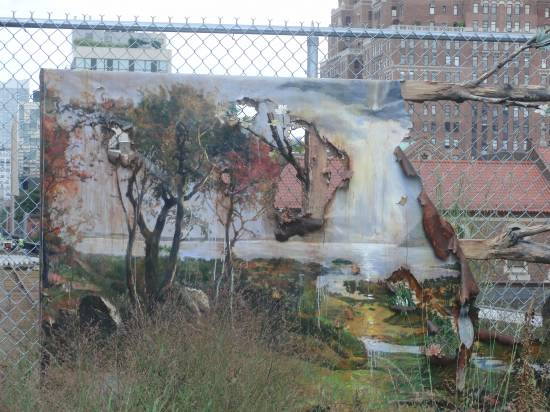The High Line
Fourteenth St. Passage
Through June 22, 2011
Admission: free
www.thehighline.org
www.creativetime.org
twi-ny slideshow
Last summer, a section of the High Line running from Gansevoort St. to 20th opened as a city park, stunningly designed by Diller Scofidio + Renfro and landscape architects James Corner Field Operations. Between 1934 and 1980, the elevated railway line supplied passage for freight trains from West 34th St. to Spring, then fell into disrepair in the 1980s and 1990s before being rescued by the Friends of the High Line, who worked tirelessly for years to turn the tracks, which were overgrown by weeds and covered in trash, into a usable public space. And what a public space it is, a gorgeous walkway filled with colorful plants and trees, smartly designed benches and loungers, and a fabulous viewing platform that looks out over Tenth Ave. This month, the park is hosting free exercise classes, walking tours, and stargazing on Tuesdays, with Wild Wednesday #4: Weed Wars! Uninvited Guests on the High Line scheduled for August 25. September will include history and nature walking tours, film screenings, yoga, kids drawing classes, live music and dance, and more. (Some events require advance RSVPs and paid tickets, while others are free with no reservations necessary.)
The High Line — the next section of which is scheduled to open in 2011 — is also home to several fascinating art projects. The most exciting is Stephen Vitiello’s “A Bell for Every Minute,” a sound sculpture, commissioned by Creative Time, that is set up in the 14th St. Passage. The Richmond-based artist and electronic musician, who was born in New York City in 1964, worked under Nam June Paik, and is associate professor of kinetic imaging at Virginia Commonwealth University, recorded the chimes of fifty-nine bells in the New York City and surrounding area, from the historic clock at Gracie Mansion to the Jefferson Market Library’s bell tower, from the John J. Harvey’s fireboat bell to the Ashokan Center’s sleigh bell, from the United Nations peace bell and the Coney Island Dreamland bell to Central Park’s Delacorte Clock and Juilliard’s school bells, in addition to chimes from Battery Park City, Governors Island, the Mahayana Temple, Green-Wood Cemetery, the Brooklyn Heights Synagogue, Aqueduct, Gleason’s Gym, Trinity Church, and the Frying Pan, among others. Each bell has its own assigned minute in which it rings for a few seconds, echoing in the chamber, before they all come together at the top of the hour, chiming in unison, creating a wondrous cacophony that is as comforting as it is thrilling. The site-specific installation also features a metallic map that locates where each sound comes from, with lines overlapping each other, adding a cool visual aspect to the piece.

Valerie Hegarty, “Autumn on the Hudson Valley with Branches,” mixed media, including acrylic paint on vinyl, fiberglass, aluminum wire, epoxy, resin, plywood, fabric, and plastic, 2009 (photo by twi-ny/mdr)
The first installation commissioned for the High Line, Spencer Finch’s “The River That Flows Both Ways” stands in the Chelsea Market Passage. Working with Creative Time, Finch took a seven-hundred-minute journey along the Hudson River, which winds its way right alongside the High Line, taking one picture of the water every minute. He then narrowed down the various colors he captured into single pixel points that he turned into glass panes, setting them up chronologically, offering a new way to travel the Hudson. On the east side of the High Line between 17th & 18th Sts., Richard Galpin’s “Viewing Station” gives visitors the opportunity to get a unique interpretation of the buildings right across the street. Galpin took a photograph of the scene, removed the color, transferred the image to stainless steel, and cut out shapes that match particular outlines of sections of the buildings; viewers then look through a box, lining up Galpin’s cut-out “photo” with the actual buildings, resulting in a titillating sensation that plays with space and perspective. On the 20th St. fence at the current northern end of the public part of the High Line, Valerie Hegarty has installed “Autumn on the Hudson Valley with Branches,” which comments on the life, death, and rebirth of the High Line itself. Adapted from Jasper Francis Cropsey’s 1860 painting “Autumn on the Hudson River,” Hegarty’s work appears to be a victim of time and the elements, with ragged holes and jagged tears in the canvas, the color fading terribly, and tree branches poking through. But just as the High Line has been resurrected, Hegarty’s piece hangs by the gate that will lead to the section of the park to be opened next year. And on September 7, Demetrius Oliver will be at the Tenth Ave. Square for the unveiling of his High Line commission, a twenty-five-by-seventy-five-foot billboard called “Jupiter.”